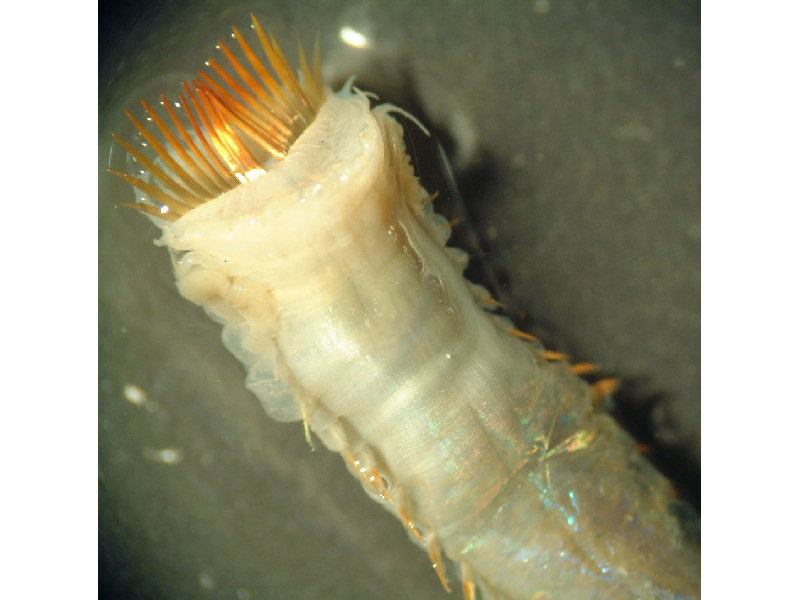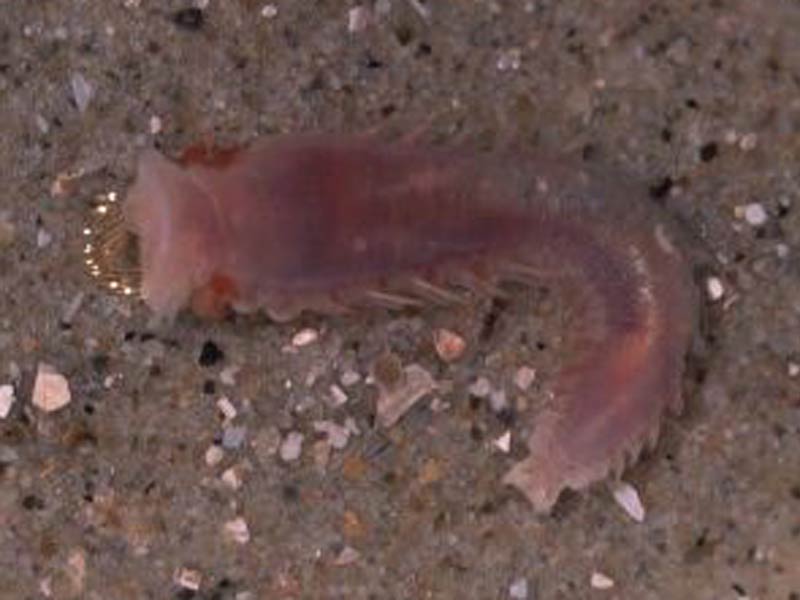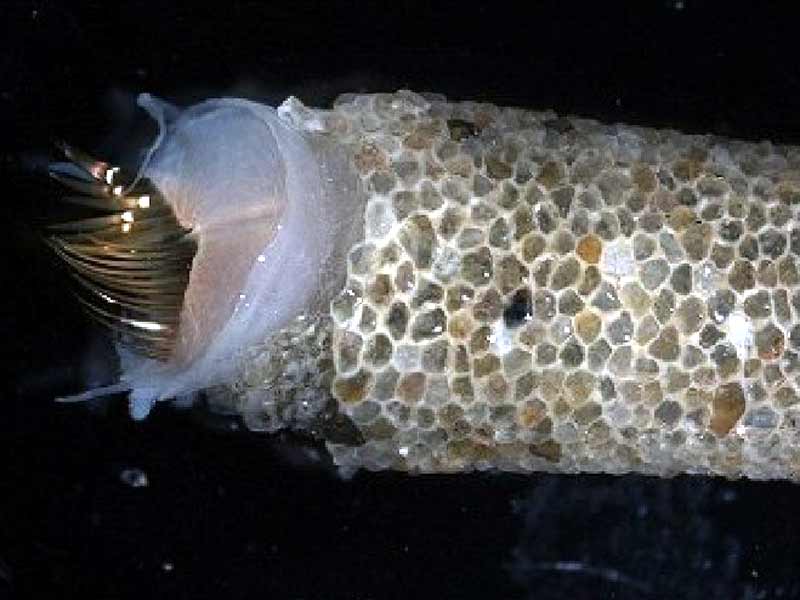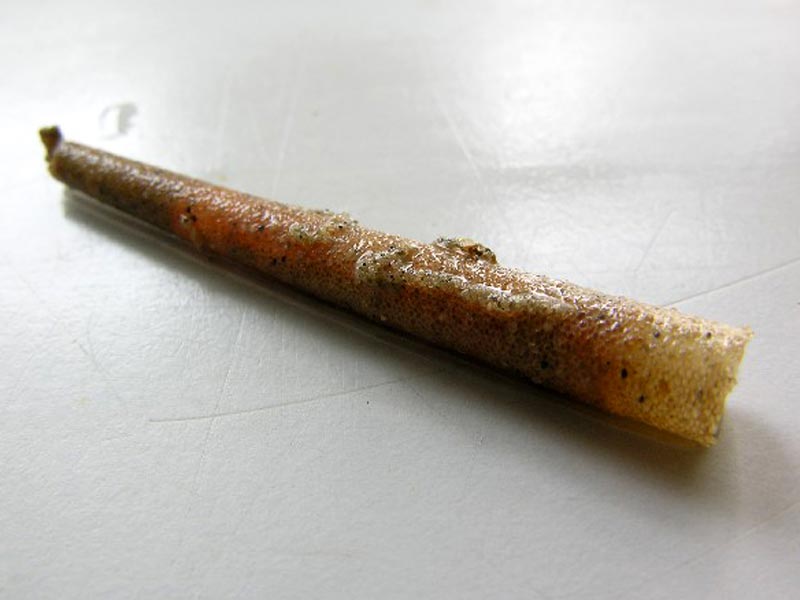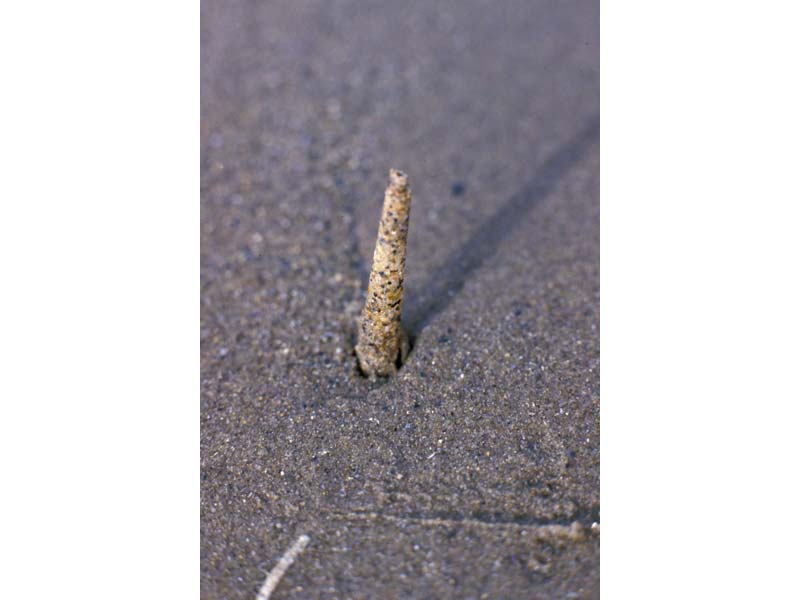A bristleworm (Lagis koreni)
Distribution data supplied by the Ocean Biodiversity Information System (OBIS). To interrogate UK data visit the NBN Atlas.Map Help
| Researched by | Edward Mayhew | Refereed by | Mike Kendall |
| Authority | Malmgren, 1866 | ||
| Other common names | - | Synonyms | Pectinaria koreni Malmgren, 1866 |
Summary
Description
Recorded distribution in Britain and Ireland
Recorded in Shetland, Orkney, the east coast from St. Andrews Bay south to Bridlington, the Wash, south east, south and south west coasts of England, the Scilly Isles, Wales, east, south and north west Ireland, and the west coast of Scotland.Global distribution
Recorded from the Arctic, Adriatic and north east Europe.Habitat
Typically found in muddy sands or sandy muds, reaching highest densities in shallow inshore regions. Also widely distributed in the North Sea and English Channel.Depth range
-Identifying features
- Body up to 5 cm long.
- 15 of it's segments bear hair-like chaetae, while the 2 segments anterior to the caudal region are without chaetae.
- Chaetae with modified hooks and dentate tips (uncini) with a massive base and between 6 and 8 rows of thick hooks above 4 rows of little, indistinct teeth.
- Has a curved membrane between anterior chaetae and buccal tentacles (cephalic veil) which is at least partly fused to the operculum, the structure at the anterior end of the body that serves to 'plug the body tube'.
Additional information
Adult densities may exceed 1000m², e.g. Eagle (1975), but numbers characteristically fluctuate widely from year to year, owing to variations in recruitment success and mortality. Lagis koreni often co-occurs with high densities of Abra alba (e.g. Eagle 1975). Lagis koreni is a significant food-source for commercially important demersal fish, especially dab and plaice, e.g. Macer (1967), Lockwood (1980) and Basimi & Grove (1985).Listed by
- none -
Bibliography
Basimi, R.A. & Grove, D.J., 1985. Estimates of daily food intake by an inshore population of Pleuronectes platessa L. off eastern Anglesey, north Wales. Journal of Fish Biology, 27, 505-520.
Day, J.H., 1967. A monograph on the Polychaeta of Southern Africa. Vol.1 - Errantia; Vol.2 - Sedentaria. London: British Museum (Natural History).
Degraer, S., Wittoeck, J., Appeltans, W., Cooreman, K., Deprez, T., Hillewaert, H., Hostens, K., Mees, J., Vanden Berghe, E. & Vincx, M., 2006. The macrobenthos atlas of the Belgian part of the North Sea. Belgian Science Policy, Brussels.
Eagle, R.A., 1975. Natural fluctuations in a soft bottom benthic community. Journal of the Marine Biological Association of the United Kingdom, 55, 865-878.
Fauchald, K., 1977. The polychaete worms. Definitions and keys to the orders, families and genera. USA: Natural History Museum of Los Angeles County.
Hayward, P.J. & Ryland, J.S. (ed.) 1995b. Handbook of the marine fauna of North-West Europe. Oxford: Oxford University Press.
Holtmann, S.E., Groenewold, A., Schrader, K.H.M., Asjes, J., Craeymeersch, J.A., Duineveld, G.C.A., van Bostelen, A.J. & van der Meer, J., 1996. Atlas of the zoobenthos of the Dutch continental shelf. Rijswijk: Ministry of Transport, Public Works and Water Management.
Howson, C.M. & Picton, B.E., 1997. The species directory of the marine fauna and flora of the British Isles and surrounding seas. Belfast: Ulster Museum. [Ulster Museum publication, no. 276.]
Lockwood, S.J., 1980. The daily food intake of O-group plaice (Pleuronectes platessa L.) under natural conditions. Journal du Conseil Permanent International pour l'Exploration de la Mer, 39, 154-159.
Macer, C.T., 1967. The food web in Red Wharf Bay (North Wales) with particular reference to young plaice (Pleuronectes platessa). Helgolander Wissenschaftliche Meeresuntersuchungen, 15, 560-573.
Rees, H.L. & Dare, P.J., 1993. Sources of mortality and associated life-cycle traits of selected benthic species: a review. MAFF Fisheries Research Data Report, no. 33., Lowestoft: MAFF Directorate of Fisheries Research.
Datasets
Centre for Environmental Data and Recording, 2018. Ulster Museum Marine Surveys of Northern Ireland Coastal Waters. Occurrence dataset https://www.nmni.com/CEDaR/CEDaR-Centre-for-Environmental-Data-and-Recording.aspx accessed via NBNAtlas.org on 2018-09-25.
Fenwick, 2018. Aphotomarine. Occurrence dataset http://www.aphotomarine.com/index.html Accessed via NBNAtlas.org on 2018-10-01
Kent Wildlife Trust, 2018. Kent Wildlife Trust Shoresearch Intertidal Survey 2004 onwards. Occurrence dataset: https://www.kentwildlifetrust.org.uk/ accessed via NBNAtlas.org on 2018-10-01.
Merseyside BioBank., 2018. Merseyside BioBank (unverified). Occurrence dataset: https://doi.org/10.15468/iou2ld accessed via GBIF.org on 2018-10-01.
Merseyside BioBank., 2018. Merseyside BioBank Active Naturalists (unverified). Occurrence dataset: https://doi.org/10.15468/smzyqf accessed via GBIF.org on 2018-10-01.
NBN (National Biodiversity Network) Atlas. Available from: https://www.nbnatlas.org.
OBIS (Ocean Biodiversity Information System), 2025. Global map of species distribution using gridded data. Available from: Ocean Biogeographic Information System. www.iobis.org. Accessed: 2025-07-15
South East Wales Biodiversity Records Centre, 2018. SEWBReC Worms (South East Wales). Occurrence dataset: https://doi.org/10.15468/5vh0w8 accessed via GBIF.org on 2018-10-02.
Citation
This review can be cited as:
Last Updated: 03/07/2007

